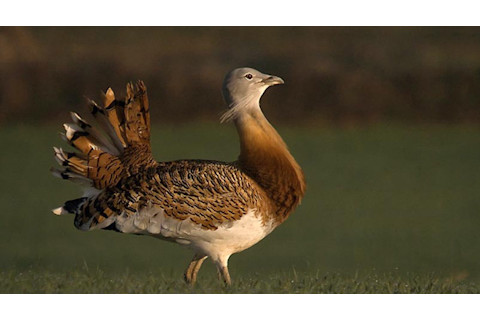
If you want to impress a female great bustard, going clean-shaven is probably the wrong approach. According to biologist Juan Carlos Alonso and colleagues at the Spanish National Museum of Natural Sciences, the size of a male bustard’s “whiskers and beard” is correlated with its reproductive success. The great bustard is a beloved but endangered bird found in Spain and other locations scattered across Eurasia. Males of the species are possibly the heaviest flying birds in the world (rivaled only by the male kori bustard), and each sports whisker-like plumage on either side of its beak, along with neck feathers that resemble a beard. They also engage in showy mating displays, strutting about “like a vicar in a tutu,” according to naturalist Chris Packham in this BBC video. According to the press release, it was unclear until now what purpose was served by the male bustard’s flamboyant facial plumage. Using transmitters to gather information on wild bustards’ beards over the course of ten years, Alonso and colleagues found that the plumes are related to bustard weight and age, and could communicate information on these stats to fellow bustards. That information is vital each February, when male bustards gather at breeding sites before females arrive. In the study, published in the journal Ethology, the researchers found that whisker number and length were positively correlated with weight during this breeding period. Since a heavier bustard is more likely to triumph over a lighter one in a fight, whiskers might help the birds avoid dangerous conflicts. Once females show up, beard size also comes into play, correlating with both weight and age. Females are more likely to select the most hirsute male bustards as mates, possibly because their more advanced age signifies greater experience. For individual males, changes in whisker and beard development from year to year correlate with “changes in its [mating] display intensity and estimated mating success.” But only the best beards will garner female attention. From the press release:
"More than half the males do no copulate, and only 10-15% of the best males obtain the majority of the copulations," explains Alonso. Despite the competition between the males, it is the females who ultimately select, from the best, "the one which will father their young.”
As of this posting, there is still no word on where these bewhiskered fellows might fall on the Trustworthiness of Beards scale
. Related Content: Discoblog: Devious Mating 101: The Lesson of the Fairy Wren and the Butcherbird
Discoblog: In the Light of a Streetlamp, Young Blue Tits Get More Action
80beats: Plastic-Loving Raptors Use Nest Decor to Advertise Their Status
The Loom: Kinkiness Beyond Kinky
Image: Carlos Palacín













